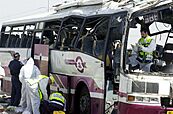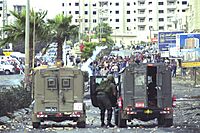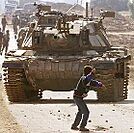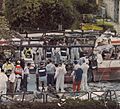Second Intifada facts for kids
Quick facts for kids Second Intifada |
|||||||||
|---|---|---|---|---|---|---|---|---|---|
| Part of the Israeli–Palestinian conflict | |||||||||
|
Clockwise from top-left:
|
|||||||||
|
|||||||||
| Belligerents | |||||||||
| Commanders and leaders | |||||||||
|
|
||||||||
| Units involved | |||||||||
|
|
||||||||
| Casualties and losses | |||||||||
|
29 September 2000 – 1 January 2005: ~1,010 Israelis total:• 644–773 Israeli civilians killed by Palestinians; • 215–301 Israeli troops killed by Palestinians |
29 September 2000 – 1 January 2005: 3,179–3,354 Palestinians total:• 2,739–3,168 Palestinians killed by Israeli troops;* • 152–406 Palestinians killed by Palestinians; • 34 Palestinians killed by Israeli civilians |
||||||||
| 55 foreign nationals/citizens total: • 45 foreigners killed by Palestinians; • 10 foreigners killed by Israeli troops |
|||||||||
| *For the controversial issue of distinguishing Palestinian civilian/combatant casualties, see § Casualties. | |||||||||
The Second Intifada (Arabic: الانتفاضة الثانية, romanized: Al-Intifāḍa aṯ-Ṯhāniya, lit. 'The Second Uprising'; Hebrew: האינתיפאדה השנייה Ha-Intifada ha-Shniya), also known as the Al-Aqsa Intifada, was a major uprising by Palestinians against the Israeli occupation, characterized by a period of heightened violence in the Palestinian territories and Israel between 2000 and 2005. The general triggers for the unrest are speculated to have been centered on the failure of the 2000 Camp David Summit, which was expected to reach a final agreement on the Israeli–Palestinian peace process in July 2000. An uptick in violent incidents started in September 2000, after Israeli politician Ariel Sharon made a provocative visit to the Al-Aqsa compound, which is situated atop the Temple Mount in East Jerusalem; the visit itself was peaceful, but, as anticipated, sparked protests and riots that Israeli police put down with rubber bullets, live ammunition, and tear gas. Within the first few days of the uprising, the IDF had fired one million rounds of ammunition.
High numbers of casualties were caused among civilians as well as combatants. The suicide bombings carried out by Palestinian assailants became one of the more prominent features of the Second Intifada and mainly targeted Israeli civilians, contrasting with the relatively less violent nature of the First Intifada, which took place between 1987 and 1993. During the first few weeks of the uprising, the ratio of Palestinians to Israelis killed was around 20 to 1. With a combined casualty figure for combatants and civilians, the violence is estimated to have resulted in the deaths of approximately 3,000 Palestinians and 1,000 Israelis, as well as 64 foreign nationals.
Many consider the Sharm el-Sheikh Summit of 2005 to have ended the uprising, as Palestinian president Mahmoud Abbas and Israeli prime minister Ariel Sharon agreed to take definitive steps to de-escalate the hostilities between the two sides: all Palestinian militant factions would stop all acts of violence against all Israelis everywhere, and Israel would likewise cease all military activity against all Palestinians everywhere. They also reaffirmed their commitment to the "roadmap for peace" that had been proposed by the Quartet on the Middle East in 2003. Additionally, Sharon agreed to release 900 of the 7,500 Palestinian prisoners held by Israel at the time and further stated that Israeli troops would withdraw from those parts of the West Bank that they had re-occupied while fighting Palestinian militants during the uprising.
Contents
Etymology
Second Intifada refers to a second Palestinian uprising, following the first Palestinian uprising, which occurred between December 1987 and 1993. "Intifada" (انتفاضة) translates into English as "uprising". Its root is an Arabic word meaning "the shaking off". It has been used in the meaning of "insurrection" in various Arab countries; the Egyptian riots of 1977, for example, were called the "bread intifada". The term refers to a revolt against the Israeli occupation of the Palestinian territories.
Al-Aqsa Intifada refers to Al-Aqsa, the main name for the mosque compound constructed in the 8th century CE atop the Temple Mount in the Old City of Jerusalem, and also known to Muslims as the Haram al-Sharif.
The Intifada is sometimes called the Oslo War (מלחמת אוסלו) by some Israelis who consider it to be the result of concessions made by Israel following the Oslo Accords, and Arafat's War, after the late Palestinian leader whom some blamed for starting it. Others have named what they consider disproportionate response to what was initially a popular uprising by unarmed demonstrators as the reason for the escalation of the Intifada into an all-out war.
Background
Oslo Accords
Under the Oslo Accords, signed in 1993 and 1995, Israel committed to the phased withdrawal of its forces from parts of the Gaza Strip and West Bank, and affirmed the Palestinian right to self-government within those areas through the creation of a Palestinian Authority. For their part, the Palestine Liberation Organization formally recognised Israel and committed to adopting responsibility for internal security in population centres in the areas evacuated. Palestinian self-rule was to last for a five-year interim period during which a permanent agreement would be negotiated. However, the realities on the ground left both sides deeply disappointed with the Oslo process. Palestinian freedom of movement reportedly worsened from 1993 to 2000. Israelis and Palestinians have blamed each other for the failure of the Oslo peace process. In the five years immediately following the signing of the Oslo accords, 405 Palestinians and 256 Israelis were killed.
From 1996 Israel made extensive contingency plans and preparations, collectively code-named "Musical Charm", in the eventuality that peace talks might fail. In 1998, after concluding that the 5-year plan stipulated in the Oslo Talks would not be completed, the IDF implemented an Operation Field of Thorns plan to conquer towns in Area C, and some areas of Gaza, and military exercises at regimental level were carried out in April 2000 to that end. Palestinian preparations were defensive, and small-scale, more to reassure the local population than to cope with an eventual attack from Israel. The intensity of these operations led one Brigadier General, Zvi Fogel to wonder whether Israel's military preparations would not turn out to be a self-fulfilling prophecy.
In 1995, Shimon Peres took the place of Yitzhak Rabin, who had been assassinated by Yigal Amir, a Jewish extremist opposed to the Oslo peace agreement. In the 1996 elections, Israelis elected a right-wing coalition led by the Likud candidate, Benjamin Netanyahu who was followed in 1999 by the Labor Party leader Ehud Barak.
Camp David Summit
From 11 to 25 July 2000, the Middle East Peace Summit at Camp David was held between the United States President Bill Clinton, Israeli Prime Minister Ehud Barak, and Palestinian Authority Chairman Yasser Arafat. The talks ultimately failed with each side blaming the other. There were five principal obstacles to agreement: borders and territorial contiguity, Jerusalem and the Temple Mount, Palestinian refugees and their right of return, Israeli security concerns and Israeli settlements. Disappointment at the situation over the summer led to a significant fracturing of the PLO as many Fatah factions abandoned it to join Hamas and Islamic Jihad.
On 13 September 2000, Yasser Arafat and the Palestinian Legislative Council postponed the planned unilateral declaration of an independent Palestinian state.
Israeli settlements
While Peres had limited settlement construction at the request of US Secretary of State, Madeleine Albright, Netanyahu continued construction within existing Israeli settlements and put forward plans for the construction of a new neighbourhood, Har Homa, in East Jerusalem. However, he fell far short of the Shamir government's 1991–92 level and refrained from building new settlements, although the Oslo agreements stipulated no such ban. Construction of housing units before Oslo, 1991–92: 13,960; after Oslo, 1994–95: 3,840; 1996–1997: 3,570.
With the aim of marginalising the settlers' more militant wing, Barak courted moderate settler opinion, securing agreement for the dismantlement of 12 new outposts that had been constructed since the Wye River Agreement of November 1998, but the continued expansion of existing settlements with plans for 3,000 new houses in the West Bank drew strong condemnation from the Palestinian leadership. Though construction within existing settlements was permitted under the Oslo agreements, Palestinian supporters contend that any continued construction was contrary to its spirit, prejudiced the outcome of final status negotiations, and undermined Palestinian confidence in Barak's desire for peace.
Trigger for the uprising
The Second Intifada started on 28 September 2000, after Ariel Sharon, a Likud party candidate for Israeli Prime Minister, made a visit to the Temple Mount, also known as Al-Haram Al-Sharif, an area sacred to both Jews and Muslims, accompanied by over 1,000 security guards. He stated on that day, "the Temple Mount is in our hands and will remain in our hands. It is the holiest site in Judaism and it is the right of every Jew to visit the Temple Mount."
This visit was seen by Palestinians as highly provocative; and Palestinian demonstrators, throwing stones at police, were dispersed by the Israeli Army, using tear gas and rubber bullets. A riot broke out among Palestinians at the site, resulting in clashes between Israeli forces and the protesting crowd.
Some believe the Intifada started the next day, on Friday, 29 September, a day of prayers, when an Israeli police and military presence was introduced and there were major clashes and deaths.
Tactics
Unlike the First Intifada, a Palestinian civil uprising mainly focused on mass protests and general strikes, the Second Intifada rapidly turned into an armed conflict between Palestinian militant groups and the Israel Defense Forces. Palestinian tactics focused on Israeli civilians, soldiers, police and other security forces, and methods of attack included suicide bombings, launching rockets and mortars into Israel, kidnapping of both soldiers and civilians.
Israeli tactics included curbing Palestinians' movements through the setting up of checkpoints and the enforcement of strict curfews in certain areas. Infrastructural attacks against Palestinian Authority targets such as police and prisons was another method to force the Palestinian Authority to repress the anti-Israeli protests and attacks on Israeli targets.
International involvement
The international community has long taken an involvement in the Israeli–Palestinian conflict, and this involvement has only increased during the al-Aqsa Intifada. Israel currently receives $3 billion in annual military aid from the United States, excluding loan guarantees. Even though Israel is a developed industrial country, it has remained as the largest annual recipient of US foreign assistance since 1976. It is also the only recipient of US economic aid that does not have to account for how it is spent. The Palestinian Authority receives $100 million annually in military aid from the United States and $2 billion in global financial aid, including "$526 million from Arab League, $651 million from the European Union, $300 million from the US and about $238 million from the World Bank". According to the United Nations, the Palestinian territories are among the leading humanitarian aid recipients.
Additionally, private groups have become increasingly involved in the conflict, such as the International Solidarity Movement on the side of the Palestinians, and the American Israel Public Affairs Committee on the side of the Israelis.
In the 2001 and 2002 Arab League Summits, the Arab states pledged support for the Second Intifada just as they had pledged support for the First Intifada in two consecutive summits in the late 1980s.
Impact on the Oslo Accords
Since the start of the Second Intifada, the Oslo Accords began to be viewed with increasing disfavor by the Israeli public. In May 2000, seven years after the Oslo Accords and five months before the start of the Second Intifada, a survey by the Tami Steinmetz Center for Peace Research at the Tel Aviv University found that 39% of all Israelis support the Accords and that 32% believe that the Accords will result in peace in the next few years. In contrast, a survey in May 2004 found that 26% of all Israelis support the Accords and 18% believe that the Accords will result in peace in the next few years; decreases of 13% and 16% respectively. Furthermore, a later survey found that 80% of all Israelis believe the Israel Defense Forces have succeeded in dealing with the Second Intifada militarily.
Economic effects
Israel
The Israeli commerce experienced a significant negative effect, particularly due to a sharp drop in tourism. A representative of Israel's Chamber of Commerce estimated the cumulative economic damage caused by the crisis at 150 to 200 billion shekels (US$35–45 billion) – against an annual GDP of $122 billion in 2002.
Palestinian Authority
The Office of the United Nations Special Coordinator for the Middle East Peace Process (UNSCO) estimated the damage to the Palestinian economy at over $1.1 billion in the first quarter of 2002, compared to an annual GDP of $4.5 billion.
Images for kids
-
CIA remote-sensing map of areas governed by the Palestinian Authority, July 2008.
See also
- First Intifada (1987–1993)
- Taba Summit (2001)
- Sharm el-Sheikh Summit of 2005
- Israeli disengagement from Gaza (2005)
- Israeli West Bank barrier – started in 2002
- Sumud (steadfastness)
- 1990 Temple Mount riots
- Silent Intifada (2014)
- Israeli–Palestinian conflict (2015)
- Palestinian nationalism
- Palestinian territories
- List of modern conflicts in the Middle East















